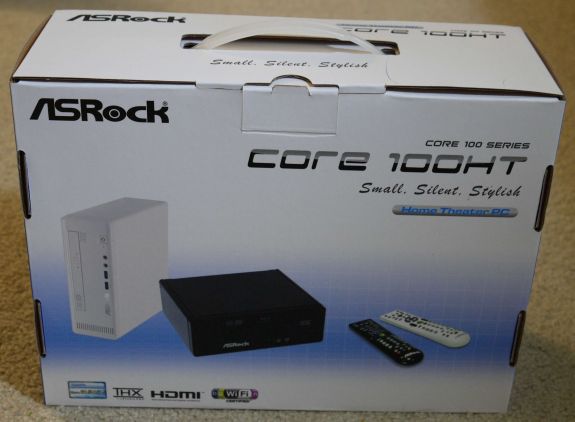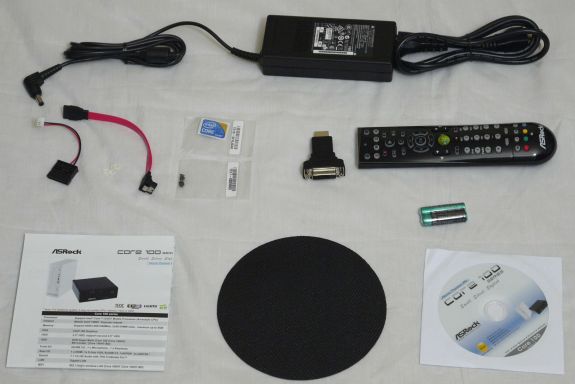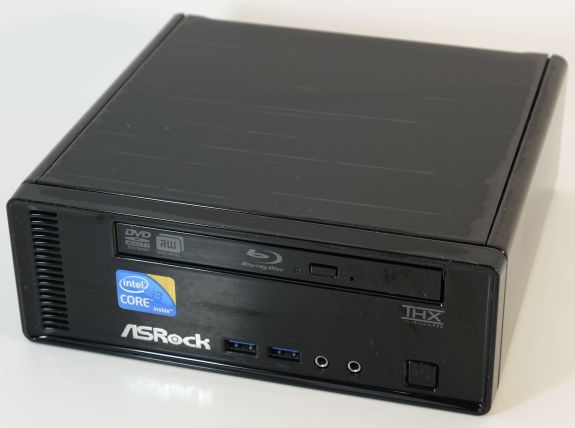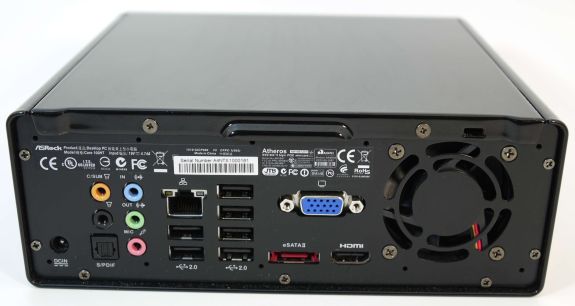ASRock Core 100HT-BD : Bringing HTPCs to the Mainstream Market [UPDATED : Noise Issue]
by Ganesh T S on July 19, 2010 9:34 PM EST- Posted in
- Home Theater
- Arrandale
- ASRock
- Media Streamer
- Core i3
- HTPC
The Core 100 HT-BD comes in a small package, and at first you wonder how such a powerful unit could come in such a small size.
Apart from the main unit, the package also bundles the following:
1. 90W AC / DC Adapter
2. SATA and power cables, as well as mounting screws for an optional second 2.5" hard disk
3. HDMI to DVI adapter
4. MCE remote and batteries.
5. Manual with instructions for disassembling and mounting the optional disk drive
6. Anti-slip pad for the base of the unit
7. CD with drivers and ASRock utilities
The appearance and dimensions of the unit are very similar to that of the ION 330-HT that was reviewed last August. The build quality of the chassis is top notch, and the unit will have no problem in blending with the A/V equipment of most consumers. However, the abrupt edges of the unit will not sit well with those interested more in the aesthetics and appearance rather than the internal capabilities of the unit. In the next iteration of the product, ASRock will probably work on the industrial design a bit more. Replacing the slimline Blu-Ray drive with a slot-loading type drive would also improve the appearance. These types of changes would enable them to cater to the segment of consumers who go more by the looks also.
We had mentioned in the ION 330 review about the absence of ports on the front panel being a bit strange, and ASRock has duly taken note, putting two USB 3.0 ports on the front panel. In addition, we also have headphone and microphone jacks in front. A set of vents on the left of the front panel helps in cooling the unit by maintaining air circulation. The slimline Blu-Ray drive is the same as those which make an appearance in various notebooks. The cost of such drives has come down drastically in the last 1 year, and we don't expect this component to add on too much cost over the DVD drive only version. Notably absent in the ION 330, but making an appearance in this unit is the THX logo above the power button to the right of the front panel.
ASRock uses the two sides of the unit as antennae for the Atheros WiFi module. Moving on to the rear of the unit, we find the adapter power input, followed by the audio ports. Analog audio output can be connected directly to the speakers, or the optical SPDIF output can be used to connect to older A/V receivers. Following this is the Gigabit Ethernet port, and 6 USB 2.0 slots. Further to the right, we have the VGA output (we really needed a DVI here), beneath which one gets the eSATA slot and HDMI output port. Wrapping up this panel is the ventilation fan. Our only gripe with the back panel is the placement of the eSATA port, which makes it difficult to connect external hard disks, particularly when the VGA port is being used.
Just like a notebook, this unit also supports simultaneous display on two monitors. Testing was done mostly with the HDMI output connected to a Toshiba REGZA 37" 1080p TV through an Onkyo TX-SR 606, and the VGA port connected to a old Dell monitor running at 1280x1024. It must be noted that the HDMI port on the unit is only 1.3a. This makes it impossible for the unit to drive monitors with resolutions higher than 1920x1080. Even extremely affordable 2048x1152 monitors such as this one from Dell are left unsupported at their maximum resolutions. However, we expect that this will not be a concern to buyers, since the unit will probably end up getting connected to a 1080p TV in most scenarios.
The Core 100 HT-BD ships with no OS installed. For the purpose of this review, we loaded up a copy of Windows 7 Ultimate x64. It is also possible to install Ubuntu or any other Linux distribution and still be able to take advantage of most of the HTPC functions of the system. Our analysis in the rest of the article, however, is completely from the Windows 7 standpoint.
Starting with this piece, all our media streamer and HTPC reviews will carry a table summarizing the data and A/V connectivity options for the unit from a home theater perspective. We will conclude this section with the same.
| Option | Status |
|---|---|
| HDMI | Yes [v1.3a] |
| Component | No |
| Composite | No |
| VGA | Yes |
| SPDIF | Yes [Optical] |
| Stereo | Yes |
| Option | Status |
|---|---|
| Optical Disk Drive | Yes [Blu-Ray] |
| USB | Yes [6 x v2.0, 2 x v3.0] |
| eSATA | Yes |
| LAN | Yes [ 1000 Mbps GbE ] |
| Internal HDD | Yes [ 500 GB ] |
| WiFi | Yes [ 300 Mbps 802.11n ] |
| Card Reader | No |














107 Comments
View All Comments
Goty - Monday, July 19, 2010 - link
Unfortunately, the lack of even the ability to include a TV tuner in this system kills it for me. If all I am going to do is use it as a Blu-Ray player and DLNA client, I've already got a PS3 that handles both admirably.Allio - Tuesday, July 20, 2010 - link
I agree. I don't understand the niche this system fills - if your needs aren't met by the existing set-top devices, you probably want to do serious gaming on it or use it as a DVR. What exactly does this do better than an ION system, other than be more expensive? Is anyone really encoding video on their HTPCs? That's what my power hungry quad core is for.RamarC - Tuesday, July 20, 2010 - link
ditto. as soon as i saw the external power supply, i immediately started the laptop comparison. it's bigger than a laptop but still has the same limited expansion capability. considering i just got similar a i3 based laptop for a niece going to college for only $550, i can't see why i wouldn't go with the lappy over this mini box.ganeshts - Tuesday, July 20, 2010 - link
RamarC,After having used this unit for 2 weeks in the process of writing the review, I do have to say that the same thought crossed my mind.
However, ASRock does have some compelling points:
1. HTPC centric features such as Instant Boot
2. MCE Remote + I/R Receiver
3. AiWi gaming feature
4. Expansion slot for 2nd hard disk
5. Better audio codec
6. Blu-Ray drive (may also be on the laptop)
Basically, the laptop's monitor & keyboard / trackpad get exchanged for the above features and the unit ends up at the same cost as the notebook.
quiksilvr - Tuesday, July 20, 2010 - link
That's not worth it. I suggest you return it and get a notebook. There are laptops out there with quick launch, an IR receiver, discrete graphics for actual gaming, usb ports for that 2nd hard disk, and expresscard slots for better audio codecs.And on top of all that, you get a screen, a keyboard and a trackpad and mobilitiy.
If this HTPC had discrete graphics and a $500 price tag instead of a $600-$700, then it would be pretty cool. But given that it doesn't, it's not worth it.
ganeshts - Tuesday, July 20, 2010 - link
quiksilvr,This HTPC is supposed to be a companion box for a TV, and as such its 'non-mobile' nature is supposed to lend itself to tasks such as running downloads overnight, and recording TV programs with external tuners and so on and so forth.
For a laptop with the specs you mention, the cost is probably going to be in the $900 - $1000 range. We have done the cost analysis, and it looks like ASRock is just charging a $90 premium (probably lesser if you go with the DVD drive). I believe this will be a compelling investment for people thinking about streamers such as the C-200 from PopCornHour or the Dune and other similar products. They can get an exponential rise in performance and available utilities for a couple of $100s more.
Yes, I agree that notebooks could be a great choice.. provided they fit your usage scenario.
Milleman - Wednesday, July 28, 2010 - link
I use the Zotac MAG Ion w. Intel 330, together with XBMC. Works just great as a streaming device for all my movies on the media server.ganeshts...
You should consider to include XBMC Live (dedicated SBMC Linux installation) in your reviews as well.
ganeshts - Wednesday, July 28, 2010 - link
Milleman,Thanks for your suggestion. XBMC Live doesn't support HD audio bitstreaming, which is fast becoming one of the most important aspects for HTPCs.
I will definitely keep in mind your suggestion for future reviews.
doxxius - Wednesday, July 28, 2010 - link
Well, I use the separate optical audio output jack on the rear which I connect to the audio receiver. Works great for me. But maybe some prefer to have it inside the HDMI cable.ganeshts - Tuesday, July 20, 2010 - link
For HTPC enthusiasts:1. This box can bitstream HD audio to the A/V receiver, while the ION can't.
2. The CPU is much more powerful than the Atom, and the user has the option to let the box run overnight to do tasks (such as downloads and encodes) without running their quad cores. This is a greener alternative.
The opinion that people don't run encodes on their HTPCs is because of the fact that such form factor machines (usually based on Atom) aren't capable enough. With this Arrandale offering, that possibility is getting opened up.
Usage as a DVR is possible using an external USB TV tuner.